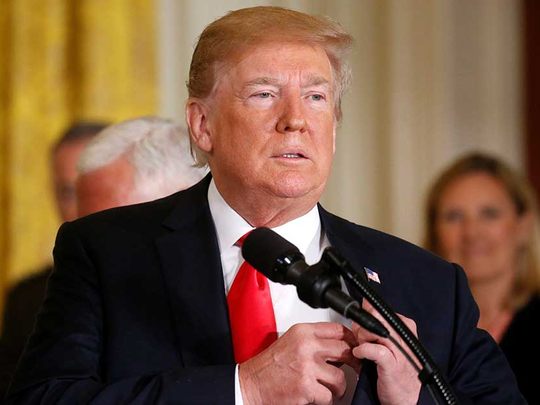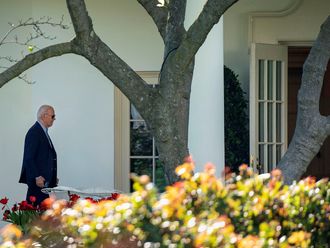
Washington, D.C.: President Donald Trump said Monday that he would direct the Defence Department and the Pentagon to create a new “Space Force” — an independent sixth branch of the armed forces.
Trump has floated this idea before — in March, he said he initially conceived it as a joke — but has offered few details about how the Space Force would operate. Several experts noted that an act of Congress is required to establish a new branch of the military.
Trump said on Monday that the branch would be “separate but equal” from the Air Force and that Gen. Joseph Dunford, chairman of the Joint Chiefs of Staff, would oversee its creation.
“It is not enough to have an American presence in space, we must have American dominance in space,” Trump said, adding that he didn’t want to see “China and other countries leading us.”
Dunford’s staff acknowledged Trump’s comments in a statement Monday afternoon, pledging to work closely with Defence Secretary Jim Mattis’ office, other Defence Department officials and Congress to “implement the President’s guidance.”
“Space is a warfighting domain, so it is vital that our military maintains its dominance and competitive advantage in that domain,” the statement said.
And a spokeswoman for Mattis said in a statement that Pentagon officials “understand” the guidance.
“Our Policy Board will begin working on this issue, which has implications for intelligence operations for the Air Force, Army, Marines and Navy,” Dana White said without elaborating. “Working with Congress, this will be a deliberate process with a great deal of input from multiple stakeholders.”
The Outer Space Treaty, which the United States signed in 1967, bars states from testing weapons and establishing military bases on the moon and other celestial bodies. It also prohibits the placement of weapons of mass destruction in orbit around Earth. Both China and Russia are signatories to the treaty. But the treaty has no enforcement mechanism (indeed, the Air Force’s unmanned space plane, the X-37B, has completed several clandestine missions).
John Logsdon, a space policy expert and professor emeritus at George Washington University, said that the treaty is generally interpreted as barring only “aggressive” military activity in space and would not prohibit the creation of a Space Force.
The idea goes back at least a year to a proposal by Republican Representative Mike Rogers and Democrat Rep. Jim Cooper. Rogers, chairman of the House Armed Services subcommittee on strategic forces, and Cooper, the ranking Democrat on the subcommittee, argued that it made sense to have a “Space Corps,” a separate branch of service with its own four-star general serving on the Joint Chiefs of Staff. Under their plan, it would have reported to the Department of the Air Force, in similar fashion to how the Marine Corps reports to the Department of the Navy.
In essence, the new service would elevate the Air Force Space Command to be on par with other military services in its own right. The command focuses on space and cyberspace operations, including the management and launch of satellites that provide Global Positioning System coordinates, weather and navigational data, and surveillance of everything from militant groups to potential ballistic missile launches.
Unlike Nasa, which focuses primarily on space exploration and scientific discovery, the new Space Force would concentrate on the military and defence aspects of space.
“I think there’s a recognition that space is an area of activity critical to our national security ... and as long as space is part of the Air Force, it’s going to take kind of second fiddle to aeroplanes,” Logsdon said.
“The threat is real,” he added, “and the history of the ability to organise and be effective in space under the Air Force, many people think, is less than optimum.”
The creation of the Space Force would mark the first time that the military has created a new branch since the 1947 National Security Act, in which Congress directed a massive overhaul of the military after the Second World War. It merged the Department of War and the Navy Department and created the Air Force from the Army Air Forces.
A full Space Force — including a service chief, service secretary and related staffs — cannot be established without a congressional act, said Jerry Hendrix, a retired Navy captain and defence analyst.
But Trump can direct the formation of an interim “Space Corps” in the meantime that still falls under the Air Force Department, but has a separate military staff, he said.
Hendrix, who advocated recently for a separate Space Force in the conservative National Review magazine, said that the Pentagon will need to make sure it decouples existing space operations from the other services.
The idea has faced resistance from senior Pentagon officials. Last fall, Rogers and Cooper’s proposal was scrapped after Mattis, Air Force Secretary Heather Wilson and Air Force Chief of Staff Gen. David Goldfein said it would lead to unnecessary costs and bureaucracy.
“I oppose the creation of a new military service and additional organisational layers at a time when we are focused on reducing overhead and integrating joint warfighting functions,” Mattis said in October in a memo to Sen. John McCain, R-Ariz., chairman of the Senate Armed Services Committee.
In a Monday news briefing, retired Air Force Lt. Gen. Dave Deptula, dean of the Air Force Association-founded Mitchell Institute for Aerospace Studies, described the decision to create a Space Force as “another example of ready, fire, aim.”
Republican Rep. Doug Lamborn applauded the move in a statement, saying that “too little emphasis has been placed on space defence.”
The announcement was made at a meeting of the National Space Council, at which Trump signed a new space policy directive aimed at space traffic management. The policy sets up new guidelines for satellite design and operation, as well as tracking the growing amount of clutter in Earth’s orbit.
But, citing the number of regulations his administration has dismantled since he took office, Trump warned the space council, “Don’t get too carried away.”
The president also reasserted plans to land astronauts on the moon again and, eventually, Mars. The president issued his first space policy directive in December, making a crewed lunar mission the centrepiece of his administration’s space strategy.
Cheryl Warner, a spokeswoman for NASA’s Human Exploration and Operations Directorate, said on Monday the space agency wants to send robotic explorers to the moon as soon as next year. Those missions would pave the way for an eventual crewed mission.
Trump’s declaration about the Space Force was one of several digressions he made during the meeting. He led off his remarks by talking for several minutes about the separation of undocumented immigrant children from their parents at the border, repeating a false claim that this is the result of a law enacted by Democrats. In fact, the separations largely stem from a “zero-tolerance policy” announced last month by Attorney General Jeff Sessions.
The president also criticised United Launch Alliance, a joint venture of Boeing and Lockheed Martin that is one of the government’s biggest space contractors, while introducing the company’s CEO:
“I don’t like when Boeing and Lockheed get together because the pricing only goes up, but that’s OK in this case,” he said. “I don’t know, I don’t love that stuff. We’re going to have to talk about that.”
But then he pivoted to emphasising the need to partner with the commercial sector, the focus of his second space policy directive, which was issued in May.
“Rich guys seem to like rockets,” Trump said. “ ... As long as it’s an American rich person, that’s good. If you beat us to Mars, we’ll be very happy, and you’ll be even more famous. We’ll save a lot of money and take the credit for it.”












